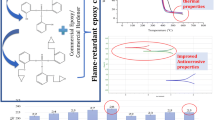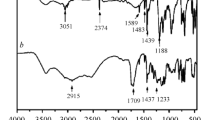Abstract
A phosphorus-containing epoxy resin has been derived from a renewable resource, sebacic acid (SA), and formulated for flame-retardant applications. The synthesized epoxy resin was characterized by physicochemical and spectral analysis including Fourier-transform infrared (FTIR), 1H and 31P nuclear magnetic resonance spectroscopies. Curing of the epoxy resin mixture was carried out with polyamide hardener at 1:1 stoichiometry on equivalent weight basis. The developed coatings were characterized in terms of their mechanical, solvent, gel content, water absorption, chemical, thermal, and flame-retardant properties, while the glass-transition temperature and thermal stability of the coatings were analyzed by differential scanning calorimetry and thermogravimetric analysis, respectively. The results revealed that the coatings with added SA-based epoxy resin showed good mechanical, chemical, and solvent-resistance properties. The thermal profile of the coatings manifested that the char yield increased with the concentration of the SA-based epoxy resin. Limiting oxygen index (LOI) and UL-94 tests were performed to understand the flame-retardancy behavior of the synthesized coatings, revealing an enhancement as the concentration of phosphorus-containing epoxy resin was increased.










Similar content being viewed by others
References
Malshe, VC, Sikchi, M, Basics of Paint Technology Part I. Paperback–Abridged. Antar Prakash Centre for Yoga (2002)
Tesoro, G, “Epoxy Resins-Chemistry and Technology, 2nd Edition, Clayton A. May, Ed., Marcel Dekker, New York, 1988, 1,288 pp. Price: $195.00.” J. Polym. Sci. Part C: Polym. Lett. Banner, 26(12), 539. https://doi.org/10.1002/pol.1988.140261212 (1988)
Ferdosian, F, Yuan, Z, Anderson, M, Xu, C, “Thermal Performance and Thermal Decomposition Kinetics of Lignin-Based Epoxy Resins.” J. Anal. Appl. Pyrolysis, 119 124–132 (2016)
Zhao, W, Liu, J, Zhang, Y, Ban, D, “Simple Green Synthesis of Solid Polymeric Bisphenol A Bis (Diphenyl Phosphate) and Its Flame Retardancy in Epoxy Resins.” RSC Adv., 5 (98) 80415–80423 (2015)
Wang, X, Xing, W, Feng, X, Yu, B, Song, L, Hu, Y, “Functionalization of Graphene with Grafted Polyphosphamide for Flame Retardant Epoxy Composites: Synthesis, Flammability and Mechanism.” Polym. Chem., 5 (4) 1145–1154 (2014)
More Troubling News About BPA/Science News. sciencenews.org. 2009
Erler, C, Novak, J, “Bisphenol A Exposure: Human Risk and Health Policy.” J. Pediatr. Nurs., 25 (5) 400–407 (2010)
Fache, M, Viola, A, Auvergne, R, Boutevin, B, Caillol, S, “Biobased Epoxy Thermosets from Vanillin-Derived Oligomers.” Eur. Polym. J., 68 526–535 (2015)
Rapi, Z, Szolnoki, B, Bako, P, Niedermann, P, Toldy, A, Bodzay, B, Keglevich, G, Marosi, G, “Synthesis and Characterization of Biobased Epoxy Monomers Derived from D-Glucose.” Eur. Polym. J., 67 375–382 (2015)
Nouailhas, H, Aouf, C, Le Guerneve, C, Caillol, S, Boutevin, B, Fulcrand, H, “Synthesis and Properties of Biobased Epoxy Resins. Part 1. Glycidylation of Flavonoids by Epichlorohydrin.” J. Polym. Sci. Part A Polym. Chem., 49 2261–2270 (2011)
Stemmelen, M, Pessel, F, Lapinte, V, Caillol, S, Habas, JP, Robin, JJ, “A Fully Biobased Epoxy Resin from Vegetable Oils: From the Synthesis of the Precursors by Thiol-Ene Reaction to the Study of the Final Material.” J. Polym. Sci. Polym. Chem., 49 (2434–2444) 24 (2011)
Lukaszczyk, J, Janicki, B, Kaczmarek, M, “Synthesis and Properties of Isosorbide Based Epoxy Resin.” Eur. Polym. J., 47 1601–1606 (2011)
Kanehashi, S, Yokoyama, K, Masuda, R, Kidesaki, T, Nagai, K, Miyakoshi, T, “Preparation and Characterization of Cardanol-Based Epoxy Resin for Coating at Room Temperature Curing.” J. Appl. Polym. Sci., 130 (4) 2468–2478 (2013)
Chen, J, Nie, X, Liu, Z, Mi, Z, Zhou, Y, “Synthesis and Application of Polyepoxide Cardanol Glycidyl Ether as Biobased Polyepoxide Reactive Diluent for Epoxy Resin.” ACS Sustain. Chem. Eng., 3 1164–1171 (2015)
Fache, M, Viola, A, Auvergne, R, Boutevin, B, Caillol, S, “Biobased Epoxy Thermosets from Vanillin-Derived Oligomers.” Eur. Polym. J., 68 526–535 (2015)
Menard, R, Negrell, C, Fache, M, Ferry, L, Sonnier, R, David, G, “From a Bio-based Phosphorus-Containing Epoxy Monomer to Fully Bio-based Flame-Retardant Thermosets.” RSC Adv., 5 70856–70867 (2015)
Li, Y, Kim, Y, Shields, J, Davis, R, “Controlling Polyurethane Foam Flammability and Mechanical Behaviour by Tailoring the Composition of Clay-Based Multilayer Nanocoatings.” J. Mater. Chem. A, 1 12987–12997 (2013)
Cao, J, Zhao, X, Zhao, J, Zha, J, Hu, G, Dang, Z, “Improved Thermal Conductivity and Flame Retardancy in Polystyrene/Poly(vinylidene fluoride) Blends by Controlling Selective Localization and Surface Modification of SiC Nanoparticles.” ACS Appl. Mater. Interfaces, 5 6915–6924 (2013)
Patra, D, Vangal, P, Cain, A, Cho, C, Regev, O, Grunlan, J, “Inorganic Nanoparticle Thin Film That Suppresses Flammability of Polyurethane with Only a Single Electrostatically-Assembled Bilayer.” ACS Appl. Mater. Interfaces, 6 16903–16908 (2014)
Laoutid, F, Bonnaud, L, Alexandre, M, Lopez-Cuesta, J, Dubois, P, “New Prospects in Flame Retardant Polymer Materials: From Fundamentals to Nanocomposites.” Mater. Sci. Eng. R, 63 100–125 (2009)
Randoux, T, Vanovervelt, J, Bergen, H, Camino, G, “Halogen-Free Flame Retardant Radiation Curable Coatings.” Prog. Org. Coat., 45 281–289 (2002)
Liu, J, Tang, J, Wang, X, Wu, D, “Synthesis, Characterization and Curing Properties of a Novel Cyclolinear Phosphazene-Based Epoxy Resin for Halogen-Free Flame Retardancy and High Performance.” RSC Adv., 2 5789–5799 (2012)
Zhang, Z, Yuan, L, Liang, G, Gu, A, Qiang, Z, Yang, C, Chen, X, “Unique Hybridized Carbon Nanotubes and Their High-Performance Flame Retarding Composites with High Smoke Suppression, Good Toughness and Low Curing Temperature.” J. Mater. Chem. A, 2 4975–4988 (2014)
Yu, L, Chen, L, Dong, L, Li, L, Wang, Y, “Organic–Inorganic Hybrid Flame Retardant: Preparation, Characterization and Application in EVA.” RSC Adv., 4 17812–17821 (2014)
Ma, C, Yu, B, Hong, N, Pan, Y, Hu, W, Hu, Y, “Facile Synthesis of a Highly Efficient, Halogen-Free, and Intumescent Flame Retardant for Epoxy Resins: Thermal Properties, Combustion Behaviors, and Flame-Retardant Mechanisms.” Ind. Eng. Chem. Res., 55 (41) 10868–10879 (2016)
Xu, W, Wirasaputra, A, Liu, S, Yuan, Y, Zhao, J, “Highly Effective Flame Retarded Epoxy Resin Cured by DOPO-Based Co-curing Agent.” Polym. Degrad. Stab., 122 44–51 (2015)
Tan, Y, Shao, Z, Chen, X, Long, J, Chen, L, Wang, Y, “Novel Multifunctional Organic-Inorganic Hybrid Curing Agent with High Flame-Retardant Efficiency for Epoxy Resin.” ACS Appl. Mater. Interface, 7 17919–17928 (2015)
Jian, R, Wang, P, Xia, L, Yu, X, Zheng, X, Shao, Z, “Low-Flammability Epoxy Resins with Improved Mechanical Properties Using a Lewis Base Based on Phosphaphenanthrene and 2-Aminothiazole.” J. Mater. Sci. https://doi.org/10.1007/s10853-017-1102-x (2017)
Alcon, M, Ribera, G, Galia, M, Cadiz, V, “Synthesis, Characterization and Polymerization of Isobutylbis-(glycidylpropylether)phosphine Oxide.” Polymer, 44 7291–7298 (2003)
Zhao, X, Vignesh Babu, H, Llorca, J, Wang, D, “Impact of Halogen-Free Flame Retardant with Varied Phosphorus Chemical Surrounding on the Properties of Diglycidyl Ether of Bisphenol-A Type Epoxy Resin: Synthesis, Fire Behaviour, Flame-retardant Mechanism and Mechanical Properties.” RSC Adv., 6 59226–59236 (2016)
Lin, C, Cai, X, Lin, H, “Flame-Retardant Epoxy Resins with High Glass-Transition Temperatures. II. Using a Novel Hexafunctional Curing Agent: 9,10-Dihydro-9-oxa-10-phosphaphenanthrene 10-yl-tris(4-aminophenyl) Methane.” J. Polym. Sci., Part A: Polym. Chem., 43 5971–5986 (2005)
Ma, S, Liu, X, Jiang, Y, Tang, Z, Zhang, C, Zhu, J, “Bio-Based Epoxy Resin from Itaconic Acid and Its Thermosets Cured with Anhydride and Comonomer.” Green Chem., 15 245–254 (2013)
Tomita, H, Yonezawa, K, “Epoxy Resin and Process for Preparing the Same.” US Patent 4540802, 1985
Song, L, Hongxia, Y, Shuyao, F, Song, N, “Synthesis and Characterization of a Phosphorus-Containing Flame Retardant with Double Bonds and Its Application in Bismaleimide Resins.” RSC Adv., 5 101480–101486 (2015)
Wazarkar, K, Kathalewar, M, Sabnis, A, “Improvement in Flame Retardancy of Polyurethane Dispersions by Newer Reactive Flame Retardant.” Prog. Org. Coat., 87 75–82 (2015)
Patil, D, Phalak, G, Mhaske, S, “Design and Synthesis of Bio-based UV Curable PU Acrylate Resin from Itaconic Acid for Coating Applications.” Des Monomers Polym., 20 (1) 269–282 (2017)
Liu, R, Wang, X, “Synthesis, Characterization, Thermal Properties and Flame Retardancy of a Novel Nonflammable Phosphazene-Based Epoxy Resin.” Polym. Degrad. Stab., 94 617–624 (2009)
Dai, J, Ma, S, Wu, Y, Ha, L, Zhang, L, Zhu, J, Liu, X, “Polyesters Derived from Itaconic Acid for the Properties and Bio-based Content Enhancement of Soybean Oil-Based Thermosets.” Green Chem., 17 2383–2392 (2015)
Aouf, C, Nouailhas, H, Fache, M, Caillol, S, Boutevin, B, Fulcrand, F, “Multi-functionalization of Gallic Acid. Synthesis of a Novel Bio-based Epoxy Resin.” Eur. Polym. J., 49 1185–1195 (2013)
Su, WFA, Chen, KC, Tseng, SY, “Effects of Chemical Structure Changes on Thermal, Mechanical, and Crystalline Properties of Rigid Rod Epoxy Resins.” J. Appl. Polym. Sci., 78 446–451 (2000)
Thomas, JN, Teluka, PG, Dean, CW, “Catalyzed Crosslinking of Highly Functional Biobased Epoxy Resins.” J. Coat. Technol. Res., 10 (5) 589–600 (2013)
Chuan, SW, Ying, LL, Yie, SC, “Epoxy Resins Possessing Flame Retardant Elements from Silicon Incorporated Compounds Cured with Phosphorus or Nitrogen Containing Curing Agents.” Polymer, 43 4277–4284 (2002)
Wang, X, Hu, Y, Song, L, Xing, W, Lu, H, “Thermal Degradation Behaviours of Epoxy Resins/POSS Hybrids and Phosphorus-Silicon Synergism of Flame Retardancy.” J. Polym. Sci., 48 693–705 (2010)
Author information
Authors and Affiliations
Corresponding author
Rights and permissions
About this article
Cite this article
Patil, D.M., Phalak, G.A. & Mhaske, S.T. Novel phosphorus-containing epoxy resin from renewable resource for flame-retardant coating applications. J Coat Technol Res 16, 531–542 (2019). https://doi.org/10.1007/s11998-018-0116-x
Published:
Issue Date:
DOI: https://doi.org/10.1007/s11998-018-0116-x




